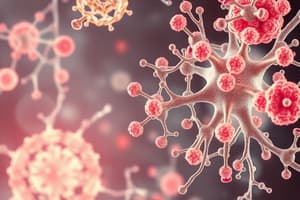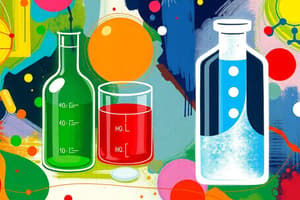Podcast
Questions and Answers
Which statement accurately describes the behavior of un-ionized acids?
Which statement accurately describes the behavior of un-ionized acids?
- They donate protons to form ionized conjugate bases. (correct)
- They donate electrons to form un-ionized conjugate bases.
- They accept electrons to form ionized conjugate acids.
- They accept protons to form ionized conjugate acids.
In an acid-base reaction, what role does water play when it accepts a proton from an acidic drug?
In an acid-base reaction, what role does water play when it accepts a proton from an acidic drug?
- It acts as a weak base, forming a hydronium ion. (correct)
- It acts as a strong acid, forming a hydroxide anion.
- It acts as a strong base, forming a hydronium ion.
- It acts as a weak acid, forming a hydroxide anion.
What does a low pKa value indicate regarding the strength of an acid?
What does a low pKa value indicate regarding the strength of an acid?
- It indicates a weak acid with equilibrium favoring the reactants.
- It indicates a strong acid with equilibrium favoring the products. (correct)
- It indicates a strong base with equilibrium favoring the products.
- It indicates a neutral compound.
For a drug that is a weak acid, how does increasing the pH of the environment affect its ionization?
For a drug that is a weak acid, how does increasing the pH of the environment affect its ionization?
Why is understanding a drug's acid-base chemistry important for pharmaceutical formulations?
Why is understanding a drug's acid-base chemistry important for pharmaceutical formulations?
What is the primary reason that most acidic drugs are absorbed in the intestinal tract rather than in the stomach?
What is the primary reason that most acidic drugs are absorbed in the intestinal tract rather than in the stomach?
How does the ionization state of a drug (HA vs. BH+) affect its ability to cross nonpolar membranes?
How does the ionization state of a drug (HA vs. BH+) affect its ability to cross nonpolar membranes?
If a drug has a pKa of 5 and is in a solution with a pH of 7, what would be the approximate ratio of the ionized to un-ionized forms of the drug, assuming it is an HA acid?
If a drug has a pKa of 5 and is in a solution with a pH of 7, what would be the approximate ratio of the ionized to un-ionized forms of the drug, assuming it is an HA acid?
A weak acid drug with a pKa of 4.0 is administered intravenously. If the plasma pH is 7.4, calculate the percentage of the drug that exists in the ionized form in the plasma.
A weak acid drug with a pKa of 4.0 is administered intravenously. If the plasma pH is 7.4, calculate the percentage of the drug that exists in the ionized form in the plasma.
A novel drug, 'Compound X', is designed to target the central nervous system. It is a weak base with a pKa of 8. If the pH of the blood-brain barrier (BBB) is approximately 7.4, and considering that only the un-ionized form of the drug can effectively cross the BBB, what percentage of Compound X will be available to cross the BBB in its un-ionized form?
A novel drug, 'Compound X', is designed to target the central nervous system. It is a weak base with a pKa of 8. If the pH of the blood-brain barrier (BBB) is approximately 7.4, and considering that only the un-ionized form of the drug can effectively cross the BBB, what percentage of Compound X will be available to cross the BBB in its un-ionized form?
Flashcards
What is an acid?
What is an acid?
A proton donor.
What is a base?
What is a base?
A proton acceptor.
Acids -> Conjugate Bases
Acids -> Conjugate Bases
Un-ionized acids donate protons forming ionized conjugate bases.
Ionized Acids
Ionized Acids
Signup and view all the flashcards
Amphoteric Water
Amphoteric Water
Signup and view all the flashcards
What is pKa?
What is pKa?
Signup and view all the flashcards
Ka or pKa
Ka or pKa
Signup and view all the flashcards
Ka & Equilibrium
Ka & Equilibrium
Signup and view all the flashcards
pH = pKa
pH = pKa
Signup and view all the flashcards
Drug Distribution
Drug Distribution
Signup and view all the flashcards
Study Notes
- Most drugs can be classified as acids or bases, and their acid-base properties greatly influence their biodistribution.
Acid and Base Definitions
- Acids are proton donors, while bases are proton acceptors.
- Un-ionized acids, such as carboxylic acids, donate protons to form ionized conjugate bases like carboxylate.
- Ionized acids, such as ammonium compounds, donate protons to yield un-ionized conjugate bases like amine derivatives.
- Un-ionized and ionized bases accept protons, forming their ionized and un-ionized conjugate acids.
Acid/Conjugated Base Pairs in Biological Systems
- In biological systems, drug molecules encounter water, which is amphoteric and can act as a weak base or acid.
- Water can accept a proton from acidic drugs to form hydronium ions (H3O+) or donate a proton to a basic drug to form hydroxide anions (OH-).
- Conjugate Acid: result from Above proton number
- Conjugate Base: result from Below proton number
Acid Strength and pKa
- Acid strength is gauged by two main factors predict the direction of acid-base reactions and measure the completion extent.
- pKapKa is a concept that refers to the negative logarithm of the acid dissociation constant (Ka) of a particular acid in solution. This measure provides insights into the strength of the acid; the lower the pKa value, the stronger the acid, reflecting a greater tendency to donate protons (H+ ions) in aqueous environments. pKa values are crucial in understanding acid-base equilibria and are widely used in fields such as chemistry, biochemistry, and environmental science. They also play a significant role in biological systems, determining how substances behave under varying pH conditions. is the Physicochemical measurement for acid strength, and is the negative logarithm of the modified equilibrium constant (Ka).
- Ka can be calculated using the concentrations of conjugate acid, conjugate base, and acid and is a modified equilibrium constant indicating how much an acid (proton donor) reacts with water to form conjugate acid and conjugate base.
- For a strong acid (low pKa), the equilibrium in water favors the formation of conjugate acid and conjugate base.
- For a weak acid (high pKa), the equilibrium in water favors the parent acid over the conjugate acid
- A pKa for a base (B) is the pKa of its conjugate acid (BH+), and the pKa for an acid (AH) is the pKa of its conjugate base (A-).
Examples of Acid-Base Reactions
- Hydrochloric acid (HCl) reacts with water to form hydronium ions (H3O+) and chloride ions (Cl-).
- Sodium hydroxide (NaOH) generates hydroxide ions (OH-) in water.
- Sodium dihydrogen phosphate (H2PO4-) reacts with water to form hydronium ions (H3O+) and monohydrogen phosphate (HPO42-).
- Ammonium chloride (NH4+) reacts with water to form hydronium ions (H3O+) and ammonia (NH3).
- Acetic acid (CH3COOH) reacts with water to form hydronium ions (H3O+) and acetate ions (CH3COO-).
- Ka of 1.26 x 10^6 for hydrochloric acid means the product of the molar concentrations of conjugate acid (H3O+) and conjugate base (Cl-) is very high relative to the term [HCl]
- Free ephedrine is an excellent proton acceptor.
Rules to Determine the Strength of a Chemical
- pKa < 2: strong acid; conjugate base has no meaningful basic properties in water
- pKa 4 to 6: weak acid; weak conjugate base
- pKa 8 to 10: very weak acid; conjugate base gets stronger
- pKa >12: essentially no acidic properties in water; strong conjugate base
Percent Ionization and Drug Solubility
- Adjusting the pH with the drug's pKa can optimize water solubility (ionic form) or solubility in nonpolar media (un-ionic form).
- HA acids go from un-ionized acids to ionized conjugate bases, while BH+ acids go from ionized (polar) acids to un-ionized (nonpolar) conjugate bases.
- In general, pharmaceutically important HA acids include inorganic acids, enols, carboxylic acids, and amides and imides.
- Percent ionization of a drug is calculated using equations involving pKa and pH for HA and BH+ acids.
- When pH equals pKa, the compound is 50% ionized.
- Increasing alkalinity by 1 pH unit from the pKa causes HA acids to become 90.9% ionized and BH+ acids to decrease to 9.1% ionization
Examples of Percent Ionization for Specific Drugs
- Phenytoin (HA acid; pKa 8.3) injection requires adjustment to pH 12 with sodium hydroxide to ensure complete ionization and maximize water solubility.
- Tropicamide is an anticholinergic drug for eye examinations needs to be buffered near pH 4 for >90% ionization due to its pKa of 5.2
- Indomethacin (HA acid; pKa 4.5) requires is intravenously administered , as the sodium salt,
Drug Distribution, pKa
- The pKa influences drug pharmacokinetics: Ionized drugs distribute more rapidly, while un-ionized (nonpolar) molecules pass through nonpolar membranes to reach the action site.
- HA acids with pKa's of 4 to 5 are absorbed partially through the gastric mucosa, while amines (pKa 9–10) are protonated and not absorbed until reaching the alkaline intestinal tract.
- In systemic circulation, plasma pH determines whether a drug remains in the aqueous environment of the blood or partitions into lipid membranes.
Studying That Suits You
Use AI to generate personalized quizzes and flashcards to suit your learning preferences.




